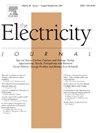Renewable energy and India's demand growth: Benchmarking aggregate energy and time-of-day feasibility under technical and policy variability
IF 2.2
Q1 Social Sciences
引用次数: 0
Abstract
India faces rising electricity demand, which the Indian government aims to meet disproportionally with cleaner resources, e.g., with the targeted 500 GW of non-fossil capacity by 2030. However, whether this can balance demand growth or plateau coal remains uncertain. This study evaluates whether incremental RE can meet aggregate demand growth, examining time-of-day variations, asking if this can avoid higher fossil fuel use. We analyse incremental demand growth until 2030 and 2036 under diverse uncertainty, including different demand shapes and energy growth scenarios. We first assess annual energy adequacy, assuming storage shifts surplus energy into deficits, with uncertainty over varying CUFs for solar and wind, planned hydro, nuclear, and coal additions. We also examine the impact of solar-to-wind ratio, wind capacity limits, rooftop solar, and planned coal projects. Sensitivity analysis identifies the influence of demand growth, demand shape, CUFs, under-construction capacities, and solar-to-wind ratio on RE requirements and time-block surpluses/deficits. We then evaluate time-of-day demand and supply variations, analysing daily surpluses and deficits, including the role of under-construction hydro and nuclear in mitigating worst deficit days. Findings show that to meet 2030 demand growth with RE India would need 11.8 % more RE capacity than targeted. Demand growth and solar CUFs have the highest impact on RE requirements and surplus/deficit, with nonlinear effects from multiple variables. Over 100 days of renewable deficits and seasonal mismatches indicate challenges for storage, necessitating either significant RE overbuilding or greater thermal output, underscoring the need for accelerated RE deployment, grid flexibility, and demand-side measures.
可再生能源和印度需求增长:在技术和政策可变性下对总能源和每日时间可行性进行基准测试
印度面临着不断增长的电力需求,印度政府的目标是用更清洁的资源来不成比例地满足电力需求,例如,到2030年,印度的目标是非化石能源装机容量达到500吉瓦 。然而,这是否能平衡需求增长或让煤炭企稳仍不确定。本研究评估了增量可再生能源是否能够满足总需求增长,检查了一天中的时间变化,并询问这是否可以避免更高的化石燃料使用。我们分析了到2030年和2036年不同不确定性下的增量需求增长,包括不同的需求形态和能源增长情景。我们首先评估年度能源充分性,假设储能将过剩的能源转化为不足的能源,并考虑太阳能和风能、计划中的水电、核能和煤炭的不同cuf的不确定性。我们还研究了太阳能风能比、风能容量限制、屋顶太阳能和计划中的煤炭项目的影响。敏感性分析确定了需求增长、需求形态、cuf、在建能力和太阳能风能比对可再生能源需求和时间段盈余/赤字的影响。然后,我们评估每日需求和供应变化,分析每日盈余和赤字,包括在建水电和核电在缓解最严重赤字日中的作用。研究结果显示,为了满足2030年可再生能源的需求增长,印度将需要比目标高出11.8% %的可再生能源产能。需求增长和太阳能cuf对可再生能源需求和盈余/赤字的影响最大,具有多变量的非线性效应。超过100天的可再生能源短缺和季节性错配表明了储能的挑战,需要大量的可再生能源过度建设或更大的热输出,强调了加速可再生能源部署、电网灵活性和需求侧措施的必要性。
本文章由计算机程序翻译,如有差异,请以英文原文为准。
求助全文
约1分钟内获得全文
求助全文
来源期刊

Electricity Journal
Business, Management and Accounting-Business and International Management
CiteScore
5.80
自引率
0.00%
发文量
95
审稿时长
31 days
期刊介绍:
The Electricity Journal is the leading journal in electric power policy. The journal deals primarily with fuel diversity and the energy mix needed for optimal energy market performance, and therefore covers the full spectrum of energy, from coal, nuclear, natural gas and oil, to renewable energy sources including hydro, solar, geothermal and wind power. Recently, the journal has been publishing in emerging areas including energy storage, microgrid strategies, dynamic pricing, cyber security, climate change, cap and trade, distributed generation, net metering, transmission and generation market dynamics. The Electricity Journal aims to bring together the most thoughtful and influential thinkers globally from across industry, practitioners, government, policymakers and academia. The Editorial Advisory Board is comprised of electric industry thought leaders who have served as regulators, consultants, litigators, and market advocates. Their collective experience helps ensure that the most relevant and thought-provoking issues are presented to our readers, and helps navigate the emerging shape and design of the electricity/energy industry.
 求助内容:
求助内容: 应助结果提醒方式:
应助结果提醒方式:


